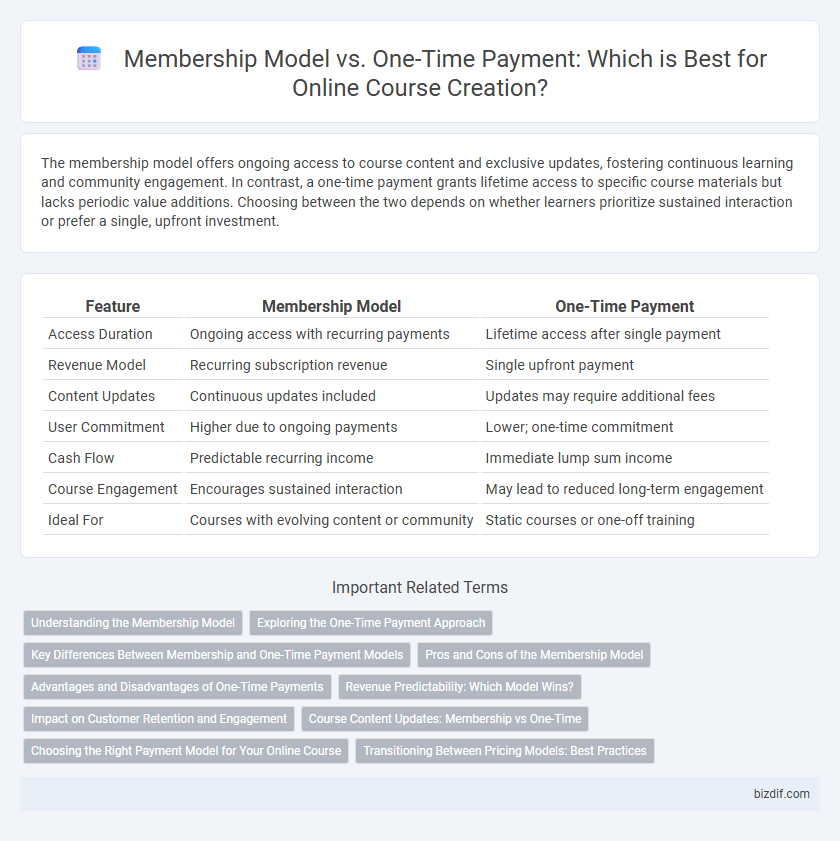The membership model offers ongoing access to course content and exclusive updates, fostering continuous learning and community engagement. In contrast, a one-time payment grants lifetime access to specific course materials but lacks periodic value additions. Choosing between the two depends on whether learners prioritize sustained interaction or prefer a single, upfront investment.
Table of Comparison
| Feature | Membership Model | One-Time Payment |
|---|---|---|
| Access Duration | Ongoing access with recurring payments | Lifetime access after single payment |
| Revenue Model | Recurring subscription revenue | Single upfront payment |
| Content Updates | Continuous updates included | Updates may require additional fees |
| User Commitment | Higher due to ongoing payments | Lower; one-time commitment |
| Cash Flow | Predictable recurring income | Immediate lump sum income |
| Course Engagement | Encourages sustained interaction | May lead to reduced long-term engagement |
| Ideal For | Courses with evolving content or community | Static courses or one-off training |
Understanding the Membership Model
The membership model offers recurring revenue through subscription fees, providing steady cash flow and fostering ongoing engagement with course content. Unlike one-time payment models, it encourages continuous value delivery and helps build a loyal community around the course material. This approach enhances customer lifetime value by incentivizing learners to stay subscribed for access to updates and exclusive resources.
Exploring the One-Time Payment Approach
The one-time payment approach in online course creation offers immediate revenue without long-term commitments, appealing to learners seeking full access upfront. This model reduces administrative complexity and enhances cash flow predictability for course creators. However, it may limit sustained engagement and recurring income compared to membership models.
Key Differences Between Membership and One-Time Payment Models
Membership models generate recurring revenue by granting continuous access to content, fostering ongoing engagement and customer retention. One-time payment models offer a single purchase for lifetime access but may limit long-term monetization opportunities and reduce consistent interaction. Pricing strategies, cash flow predictability, and customer relationship dynamics differ significantly between these two approaches.
Pros and Cons of the Membership Model
The membership model offers recurring revenue and sustained customer engagement, allowing creators to build a loyal community with continuous content updates. It can increase lifetime customer value but demands consistent content production and ongoing support, which can be resource-intensive. However, fluctuating monthly subscriptions risk higher churn rates compared to the one-time payment model, which provides immediate revenue but limits long-term income potential.
Advantages and Disadvantages of One-Time Payments
One-time payment models offer clear advantages such as upfront revenue and simplified transactions, making it easier for course creators to manage cash flow without ongoing obligations. However, they lack the recurring income potential and customer retention benefits associated with membership models, potentially limiting long-term profitability. This payment structure may also reduce opportunities for continuous engagement and upselling compared to subscription-based memberships.
Revenue Predictability: Which Model Wins?
The membership model offers superior revenue predictability by generating consistent monthly or yearly payments, enabling online course creators to forecast income and manage cash flow effectively. In contrast, the one-time payment model results in fluctuating revenue based on new enrollments, making it challenging to project long-term earnings. Subscription-based memberships foster ongoing customer engagement and reduce churn, contributing to stable, scalable revenues in the competitive e-learning market.
Impact on Customer Retention and Engagement
Membership models foster higher customer retention and engagement by offering continuous access to updated content and community interaction, encouraging ongoing participation. One-time payment structures often lead to lower long-term engagement as customers receive all content upfront without incentives for repeated visits. Consistent value delivery and recurring billing in membership models create a sustainable relationship, boosting lifetime customer value and loyalty.
Course Content Updates: Membership vs One-Time
Membership models offer continuous access to regularly updated course content, ensuring learners benefit from the latest industry trends and educational advancements. One-time payment courses provide static materials, requiring separate purchases for any content updates or expansions. Continuous content enhancement in membership-based courses significantly boosts learner engagement and long-term value compared to one-time payment models.
Choosing the Right Payment Model for Your Online Course
Choosing the right payment model for your online course depends on your target audience and revenue goals. Membership models provide recurring income and foster community engagement, while one-time payment options offer immediate, straightforward access to course content. Assessing factors like customer lifetime value, course updates frequency, and user commitment helps optimize monetization strategy and maximize profitability.
Transitioning Between Pricing Models: Best Practices
Transitioning from a one-time payment to a membership model requires clear communication about the benefits, such as recurring access and updated content, to retain existing customers. Implement gradual changes by offering exclusive perks for members while providing legacy customers transitional offers to ease adoption. Data-driven analysis of user engagement and feedback is essential for optimizing pricing strategies and maximizing long-term revenue growth in online course platforms.
Membership model vs One-time payment Infographic

 bizdif.com
bizdif.com